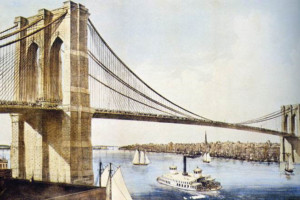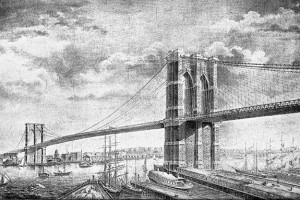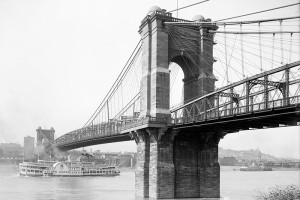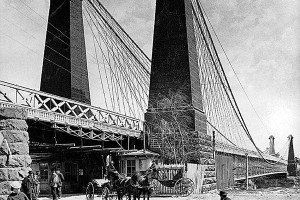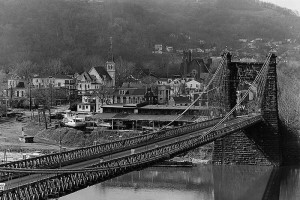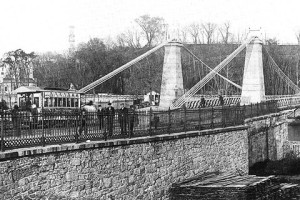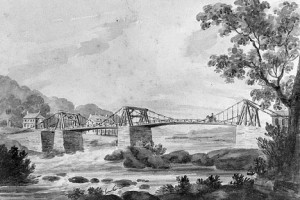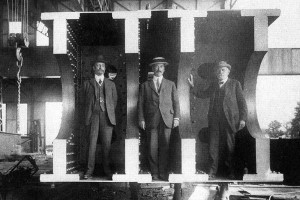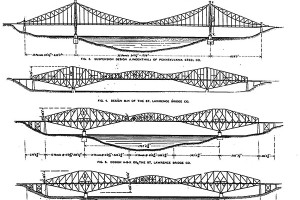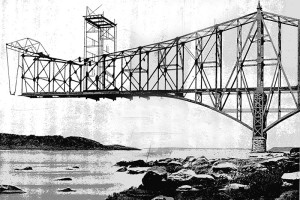Washington A. Roebling assisted his father in the design of the bridge from March 1868, after he returned from his combination honeymoon and fact-finding trip to Europe. While in Europe, he visited Telford’s Menai Straits suspension bridge, Brunel’s Clifton suspension bridge, and many others. Washington toured the steel mills of England and Germany and learned all he could about pneumatic caissons. …
Review Category : Historic Structures
The Brooklyn Bridge, across the East River in New York City, is perhaps the most recognized bridge in the United States. As a result of David McCullough’s book The Great Bridge and Ken Burns’ American Stories – Brooklyn Bridge series, many engineers know some of the backstories of the bridge. Don Sayenga’s book, Washington Roebling’s Father, also clarified which Roebling, John or Washington, built the Bridge. Part 1 starts with the earliest plans for a bridge and runs up to John Roebling’s death in 1869 before the onset of construction. …
John A. Roebling Bridge
A bridge across the Ohio River connecting Cincinnati, Ohio, and Covington, Kentucky, was suggested in the 1820s. A charter for the bridge was granted in 1826 by the State of Kentucky and a second charter approved by Kentucky in 1840. Charles Ellet, Jr. (STRUCTURE, October 2006) submitted a plan for a wire cable suspension bridge in the same year. …
The Niagara River gorge had long separated the United States from Canada. It varied in depth up to 239 feet and in width generally between 800 and 1000 feet between the Falls and Lewiston. In 1845, Charles B. Stuart, then working on the location of the Great Western Railway in Canada, was looking for a way to connect his line with the Rochester and Niagara Falls branch of the New York Central. …
A bridge had been proposed at Wheeling for many years to connect the eastern and western portions of the National Road across the Ohio River. The legislatures of Virginia and Ohio incorporated the Wheeling and Belmont Bridge Company in 1816 and authorized them to erect a bridge. The company, in 1836, built a wooden covered bridge from the west end of Zane’s Island to the Ohio shore. …
In 1838, an arsonist burned Lewis Wernwag’s Colossus Bridge (STRUCTURE, June 2014) over the Schuylkill River near Philadelphia. Its 340-foot main span was, at the time, the longest single span bridge in the United States. Charles Ellet, Jr. (STRUCTURE, October 2006) immediately proposed replacing it with a wire cable suspension bridge. By this time, several Finley Chain Bridges were built in the Philadelphia area as well as a short lived, long-but-extremely-narrow, pedestrian wire bridge across the Schuylkill River built by Josiah White and Erskine Hazard. …
This is the first in a series on early suspension bridges. It starts with James Finley (STRUCTURE, November 2008), who designed and built the first iron chain suspension bridge (1801-1802) with a horizontal deck across Jacob’s Creek just south of Mount Pleasant, Pennsylvania on Old Route 119. Chain bridges with a deck resting directly on the chain had been built for years, but were only for pedestrian traffic. …
Parts 1 and 2 of this article can be found in the December 2015 and January 2016 issues of STRUCTURE magazine.
The newly accepted design of the Quebec Bridge maintained the 1,800-foot main span with straight upper and lower chords on the anchor and cantilever spans. All of the parts, especially the lower compression chords, were much larger than the Phoenix Bridge/Cooper design. …
Part 1 of this article was published in the December issue of STRUCTURE magazine.
A total of 75 men were killed instantly, with 11 escaping with their lives, in the bridge collapse on August 29, 1907. How could this have happened? Weren’t Cooper and the Phoenix Bridge Company acknowledged to be leaders in the bridge building business? The Engineering News wrote: …
The first in a three part series on the Quebec Bridge.
In the middle of the 19th Century, the St. Lawrence River had not been bridged. In early 1852, the City Council of Quebec City requested Edward W. Serrell to make a study of the problem and make recommendations for a bridge. His major bridge at this time was the suspension bridge he built across the Niagara River connecting Lewiston and Queenstown. …

